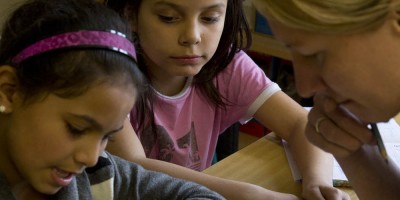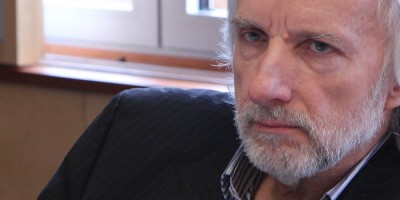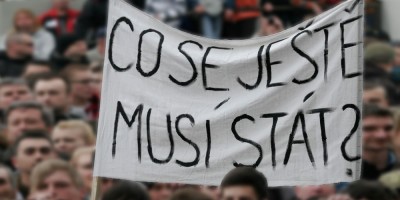
too strong conviction
in some regions, Roma continue to be sent to less demanding schools
see what factors predict labour activity of the poorest third of the Czech Roma
The pollsters simply asked for the highest education attained. The Czech Republic is one of the countries where education has a strong influence on labour activity. During the economic crisis, people with elementary education were several times more vulnerable to unemployment than the people with A Level or higher. This phenomenon exists among the Roma as well. But among them, low education is much more common among than in the general population.
We define unemployment in the district through so-called terciles in the given population. We conducted the survey at 108 locations. Then we split the locations into three groups according to the level of unemployment in the district to which they belong.
The measure of area segregation describes what researchers sometimes call Social-spatial exclusion. The high measure of segregation matches these criteria:
It is important that our definition of the measure of area segregation does not include indicators of labour activity. This enables us to investigate to what extent it relates to labour activity.
Respondents are considered to have worked if they have done at least one hour of paid work during the week before being surveyed. Besides regular employment, this includes part-time jobs, on-and-off stints and work on the grey market. It does not include beggary and illegal activity.
Only the economically active respondents. This means people who generally do not have a reason not to work (like studying or retirement) and includes both employed and unemployed. Contrary to some definitions of economically active people, we have included housewives and housemen, too.
The research targeted randomly selected areas from the so-called Gabal’s map of socially excluded localities (2006) with some updates. The map includes very segregated and neglected areas (Northwest Bohemia, Moravia-Silesia) and less segregated areas which are merely at risk of social exclusion (hostels and houses in Prague).
Similar surveys were conducted in 11 other countries of Central and Eastern Europe and the Balkans. This research is called the Roma Survey 2011 and was financed by the UNDP and FRA. The conclusions of the research can be found here.
1,100 households participated in the survey. Of that, 750 were Roma households from the excluded areas and 350 were non-Roma households in a control sample from the surroundings of the excluded areas. Occupational activity of all economically active members of the household was investigated. Hence, the total of respondents was around 1,500.
No. Only with the activity of the Roma from so-called socially excluded areas. At the time of the survey in 2011, about 80-100 thousands people lived here, including about a third of the Czech Roma. The occupational activity of the Roma integrated in the society is thought to be significantly higher. Data show that the activity of the respondent is strongly predicted by the social exclusion, rather than ethnicity as such.
No. Data show that even among the Roma from excluded areas, the occupational activity depends on education, unemployment in the region and the extent of segreagation of the area. People from excluded areas are not a mass, they are individuals. They live in an environment that limits them to various degrees. Those who manage to get better education then work much more often.
The aim of the app is not to present absolute numbers but the relations between the variables. These relations shall still be valid.
In the last census, only 13,000 Czechs reported a Roma ethnicity. To identify the ethnicity, we have therefore used a combination of observation and absence of negative self-determination. When pollsters visited what they considered to be Roma household, they informed respondents about the targeting of the survey on Roma households and conditions (anonymity, reward, use of data). If the respondents did not day they do not consider themselves Roma, the pollsters proceeded to make an interview.
The goal of the original Roma Survey 2011, as well as this app, is not to demonize an ethnic group. To scrutinize the conditions of life of socially excluded Roma matters because they face difficulties precisely for their belonging to an ethnic group. An experimental study by CERGE-EI shows, for instance, that people with a Roma name are twice as unlikely to get a reply on a job application or a flat viewing request.
The data come from declarations in a survey, so they can be influenced by the so-called Social desirability bias (a tendency to style oneself into a behavior that other view favourably). But the survey consisted a number of measures to reduce it. The labour activity of members of the household was reported by the head of the household or an informed member (not the respondent directly who has the greatest bias). The survey was anonymous. Questions were preceeded by introuctions that suggested that both answers are acceptable. Also, the aim of the app is not to show absolute number but to analyse what predicts the labour activity.
It is possible. The survey concerns itself only with people from so-called excluded areas. We can assume that with increasing education, people are more likely to leave the area. The survey can no longer detect you and yet you work elsewhere. The relation between education and labour activity can thus be even stronger than the app shows.
Some estimates would suggest that. But we must differentiate whether a respondent had an employment contract or whether he worked at all last week. The latter, which we call labour activity, includes seasonal jobs, work on the grey market, and the like. The survey was done in June and July when the labour market in unskilled labour is strong. Note that some estimates of the employment of the people from Socially Excluded Localities come from particularly segregated areas around Most and Ostrava. Our data show that the labour activity of the Roma from some of the less segregated areas is significantly higher.
The app was created in cooperation with Median.

in some regions, Roma continue to be sent to less demanding schools

opposition to inclusive education arises in part from sloppy communication

studies show inclusive education can be beneficial to all

false testimony of a mousy boy awoke memories of a pogrom that left 40 Jews dead